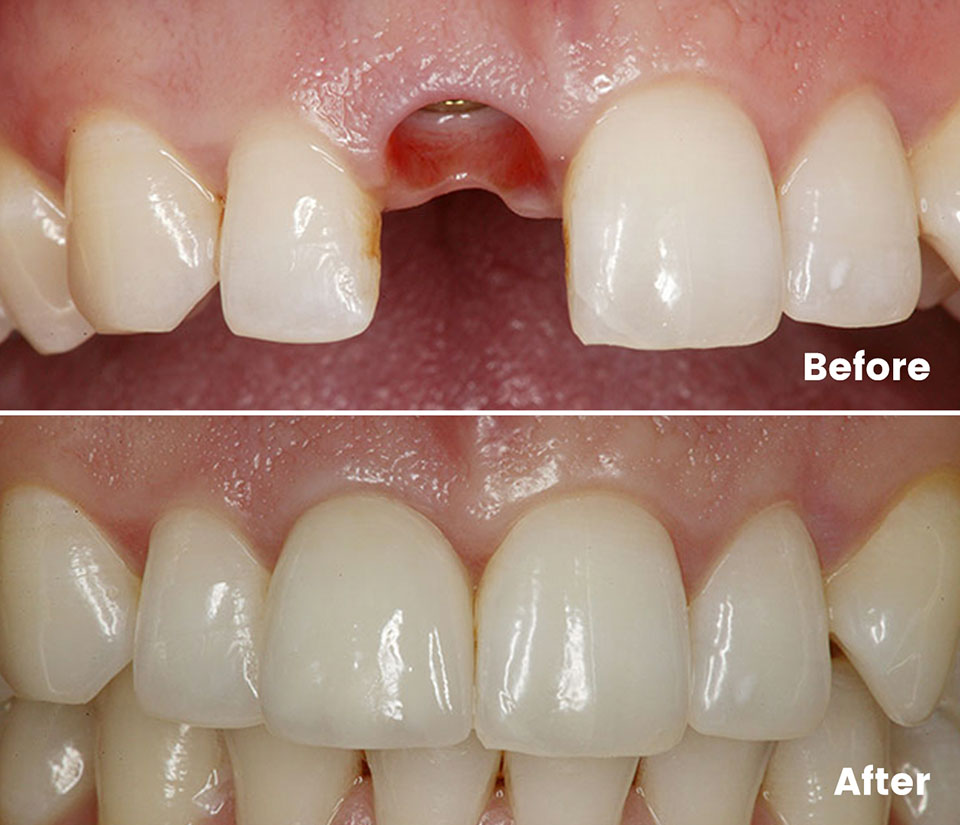A dental implant is a titanium-aluminum alloy post and is designed to replace the root of a missing tooth. The surface of the implant is treated by varying proprietary techniques rendering it biocompatible with bone. Following placement, the bone of the jaw fuses (integrates) with the implant. Once healing is complete, a crown, bridge or denture will be placed on the implant(s) by your restorative dentist. For patients with existing dentures, dental implants will dramatically increase the stability of your dentures improving your confidence when eating, smiling and speaking. Patients often find improved function, comfort and esthetics with dental implants.
Dental Implants

Tooth Replacement
“Dental implants should be viewed as a restorative treatment with a surgical component.”
Reasons for Tooth Loss
While the goal of periodontal treatment is to try to maintain and preserve your natural teeth, eventual tooth loss may be unavoidable in certain cases. A tooth may be lost for several reasons including severe periodontal disease, decay, root fracture, trauma or failed root canal treatment.
Regardless of the reason you have lost your tooth/teeth, you are likely a candidate for dental implants. Even if a tooth has been missing for many years, current techniques can be used to regenerate lost jawbone and allow for implant treatment.
When you visit our office for an evaluation for dental implants, your doctor will evaluate your teeth, gums and bone. In many cases, a three-dimensional scan known as a Cone Beam CT will be necessary to thoroughly evaluate your jawbone. This scan aids in treatment planning your case by determining if bone grafting is necessary to place an implant(s) and to assess for important structures in the jawbone such as sinus cavities and large nerves. CBCT technology provides extra level of precision and safety to patients.
Site Preparation for Implant Placement
Site preparation options vary in each patient case. For an implant to be a viable option the primary prerequisite is having adequate bone. This can be achieved by site preservation or site augmentation. These techniques refer to bone grafting either at the time of tooth extraction (preservation) or bone grafting to increase the amount of bone at an area where a tooth is already missing and maxillary sinus bone grafts (augmentation) respectively.
If a tooth must be removed, in some circumstances a dental implant can be placed at the time of tooth extraction. Other times the extraction site must be rebuilt with a bone graft and allowed to heal prior to implant placement.
Depending upon the condition of your jawbone, the time required for treatment varies. If bone grafting is needed, additional healing time may be necessary. Your doctor will discuss anticipated treatment times with you at your first appointment in our office.
As you know, your own teeth require conscientious at-home oral care and regular dental visits. Dental implants are like your own teeth and will require the same care. In order to keep your implant clean and plaque-free, brushing and flossing still apply!
After treatment, your periodontist will work closely with you and your dentist to develop the best care plan for you. Periodic follow-up visits will be scheduled to monitor your implant, teeth and gums to make sure they are healthy.

Site Preparation for Implant Placement
Site preparation options vary in each patient case. For an implant to be a viable option the primary prerequisite is having adequate bone. This can be achieved by site preservation or site augmentation. These techniques refer to bone grafting either at the time of tooth extraction (preservation) or bone grafting to increase the amount of bone at an area where a tooth is already missing and maxillary sinus bone grafts (augmentation) respectively.
If a tooth must be removed, in some circumstances a dental implant can be placed at the time of tooth extraction. Other times the extraction site must be rebuilt with a bone graft and allowed to heal prior to implant placement.
Depending upon the condition of your jawbone, the time required for treatment varies. If bone grafting is needed, additional healing time may be necessary. Your doctor will discuss anticipated treatment times with you at your first appointment in our office.
As you know, your own teeth require conscientious at-home oral care and regular dental visits. Dental implants are like your own teeth and will require the same care. In order to keep your implant clean and plaque-free, brushing and flossing still apply!
After treatment, your periodontist will work closely with you and your dentist to develop the best care plan for you. Periodic follow-up visits will be scheduled to monitor your implant, teeth and gums to make sure they are healthy.
